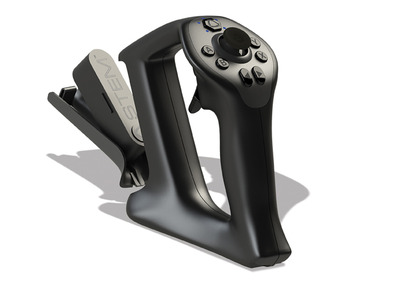Electromagnetic motion tracker for PC gaming developed
Virtual reality specialist Sixense has developed the PC gaming-targeted 3D ‘STEM System’ - a product which uses an electromagnetic field to track up to five tracking points - with the help of Nordic Semiconductor’s wireless technology.
The system utilised the Nordic nRF51822 and nRF24LU1+ devices to supply the wireless link between up to five (nRF51822) electromagnetic avatar tracking or controller modules (eg, head, hands and both feet for full-body avatars) and a 2.4 m electromagnetic field-generating base charging station (nRF51822). Each module communicates its position and orientation every 4 ms to a USB dongle (nRF24LU1+) that plugs into a host PC and runs the Nordic Gazell 2.4 GHz RF protocol stack.

By employing Nordic ULP 2.4 GHz transceivers, Sixense claims the system meets mass-market PC gaming requirements with a responsiveness that outclasses accelerometer- and camera-based motion controllers. The system is also modular, allowing users to add further controllers, trackers and other game-specific peripherals as and when they want to, and based on an open-platform architecture targeting third-party hardware and game developers.
According to Sixense, the advantage of the STEM System over other motion-based wireless controllers is that it employs an electromagnetic field to provide highly precise position and orientation tracking with complete fidelity and precision down to the nearest 1 mm (position) and degree (orientation) and, with the Nordic Semiconductor 2.4 GHz wireless link, all available for use by the end application in less than 10 ms.
Steve Nguyen, Sixense VP of Marketing, said the company “couldn’t have achieved the STEM System’s level of responsiveness without the underlying physical RF performance and reliability of the Nordic radios. Nordic allowed us to carefully finetune the Nordic-supplied proprietary Gazell software protocol in order to minimise latency and maximise performance, while ensuring the critical data link performance was maintained.”
The result, said Nguyen, is that “the sense of reality is uninterrupted when users interact with the game through the STEM System’s two-handed motion tracking controllers. Our magnetic technology knows exactly where each tracking point is located and how it’s oriented at all times relative to the STEM Base. This includes both X-Y-Z position and pitch-roll-yaw orientation. The end result is a controller that offers a finesse and fidelity that accelerometer-based systems simply do not and cannot possess, with no shadowing or drift.”
Sixense is currently developing a 3D modelling application for 3D printing called ‘MakeVR’ that combines an intuitive and natural 3D modelling environment with the STEM System. The company is also collaborating with major game publishers and developers to take advantage of its STEM System motion tracking platform.
Power electronics market set to grow
After two years of stagnancy, the power semiconductor devices market is set to prosper, according...
Faster multicore chips
Computer chips' clocks have stopped getting faster. To keep delivering performance...
Extreme-temperature electronics
Many industries are calling for electronics that can operate reliably in a harsh environment,...




